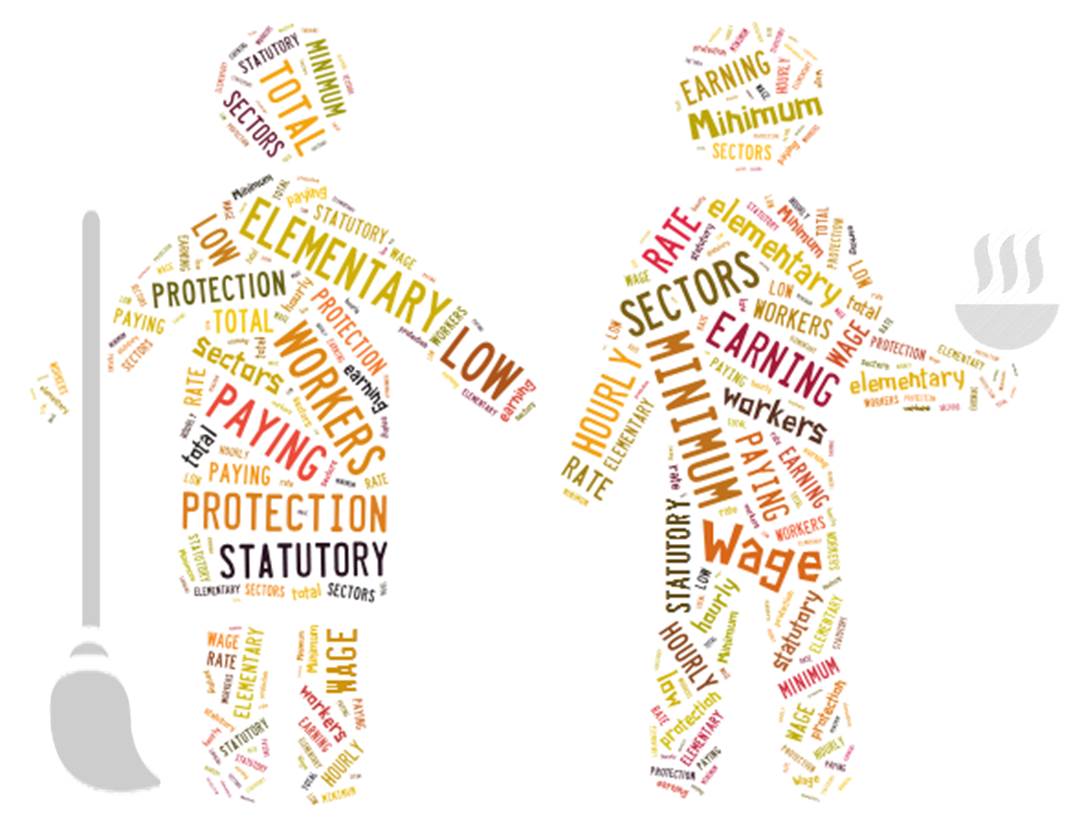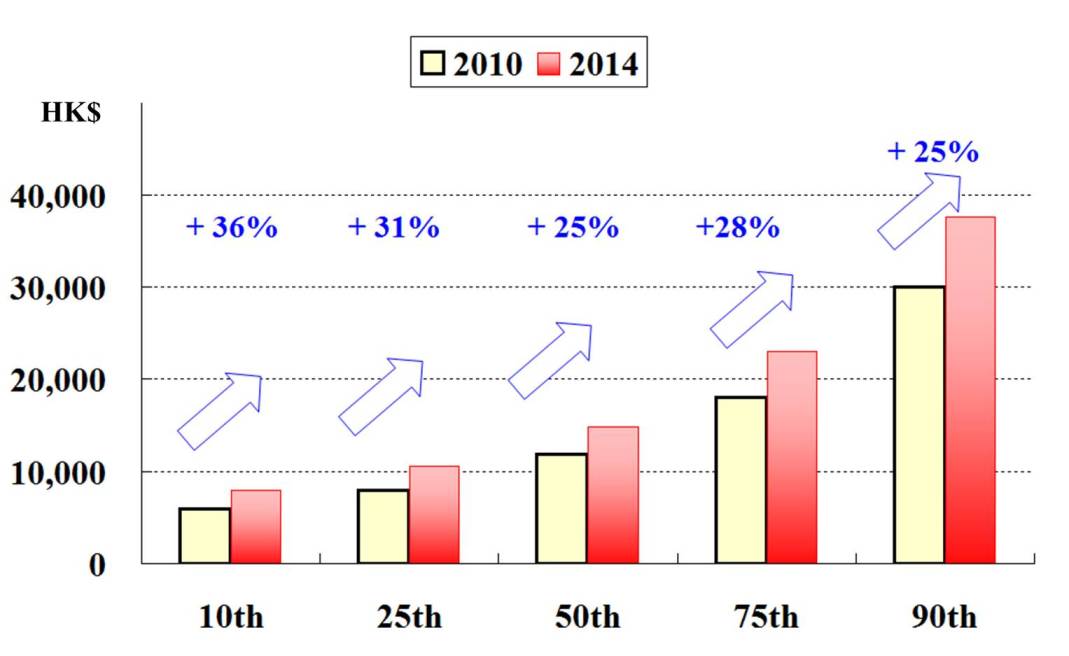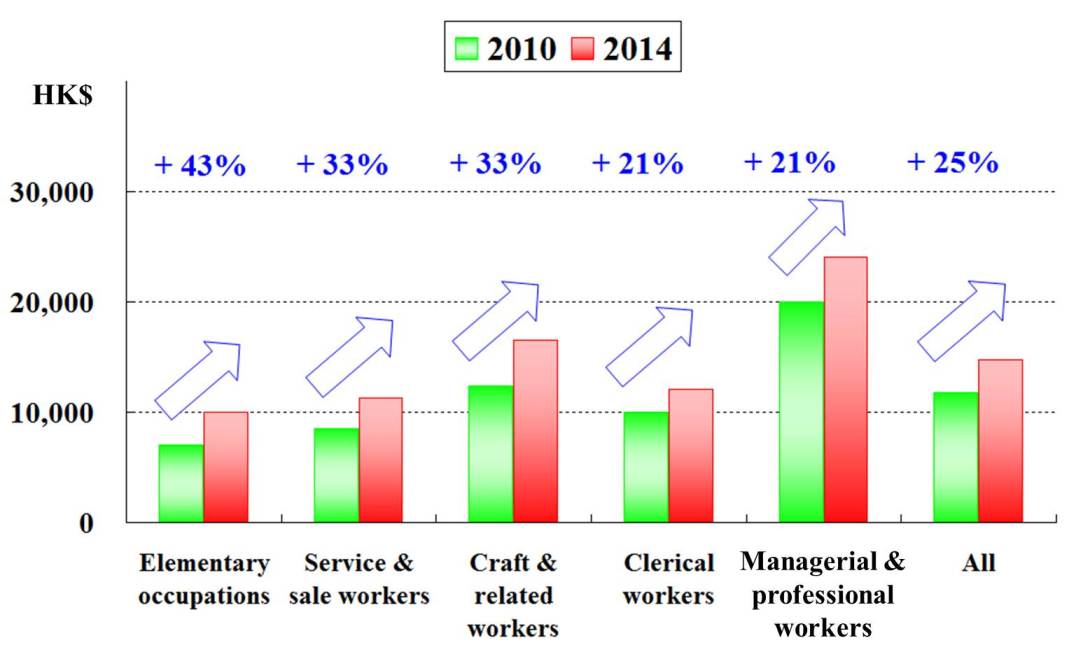ISE17/14-15
| Subject: | manpower, welfare, minimum wage |

- Statutory minimum wage was enacted in Hong Kong in July 2010 and came into effect in May 2011. The statutory hourly rate was initially set at $28, and has been progressively lifted to $30 in May 2013, and most recently to $32.5 in May 2015. The cumulative increase over the past four years was 15.7%, along with the inflation rate of 17.3% in terms of Consumer Price Index (A) over the same period.1Legend symbol denoting Consumer Price Index (A) is used as a deflator throughout this paper, as most of the indicators are related to low-income earners. Between May 2011 and May 2015, Consumer Price Index (A) went up by a total of 17.3%, faster than the respective rise of 15.7% in Composite Consumer Price Index.
- The impact of minimum wage on the labour market is still a contentious issue around the globe. While the policy objective is to offer wage protection to low-income workers, there are concerns over the possible unintended consequence of pricing out elementary workers from the job market. It is argued that unskilled workers might face greater unemployment pressure as some employers might trim such job vacancies for cost savings, and minimum wage might end up as maximum wage when employers refuse to pay more than the statutory rate. As of to date, empirical evidences in overseas economies for these conceptual arguments are rather mixed and still not conclusive.2Legend symbol denoting For a summary on the pro and cons of minimum wage legislation, please refer to Economic Development and Labour Bureau (2004).
- After four years of implementation in Hong Kong, it is opportune to review whether the minimum wage legislation has effectively protected the grassroots workers in Hong Kong, in terms of wage growth and employment opportunities. Key findings are highlighted in this issue of Essentials.
Recent wage trends of elementary workers in Hong Kong
- The Census and Statistics Department ("C&SD") published in March 2015 the "2014 Report on Annual Earnings and Hours Survey". The Report provides tailor-made data inputs for the Minimum Wage Commission ("MWC") for its biennial review of the statutory minimum wage. The ensuing paragraphs highlight some key observations on the recent developments in the local labour market.
- First, overall wages in Hong Kong have stayed on a steady uptrend in recent years after implementation of minimum wage. The median monthly wage of the entire workforce in Hong Kong stood at $14,800 in 2014, up by 25% in money terms over the 2010 level.3Legend symbol denoting The reference period for the annual wage survey conducted by C&SD for MWC is stipulated for May-June of each year. To take into account the wage impacts caused by the introduction of minimum wage in May 2011, 2010 was chosen as a base period of comparison. Netting out inflation, there was still a cumulative improvement of 6% in real terms during 2010-2014, compared with the modest increase of just around 1% during 2005-2010.
- Secondly, lower-income workers observed larger wage increases than higher-income earners. During 2010-2014, monthly wages of the bottom 10th percentile worker increased by a total of 36% in money terms or 14% in real terms. These were more than the respective rises of 25% in money terms or 6% in real terms for the 90th percentile worker (Figure 1).
Figure 1 : Monthly wages by percentile in money terms during 2010-2014

- Thirdly, unskilled workers saw more visible wage improvements than those at the higher end of occupation hierarchy. For instance, the median monthly wages of elementary workers increased by a total of 43% in money terms or 20% in real terms during 2010-2014. The increases were more appreciable in certain low-paying sectors4Legend symbol denoting Low-paying sectors cover, inter alia, (a) retail; (b) restaurants; (c) estate management; security and cleaning services; (d) elderly homes; (e) laundry and dry cleaning services; (f) hairdressing and other personal services; (g) local courier services; and (h) food processing and production sector. It is estimated that there were some 212 400 workers falling within the lowest decile in the overall hourly wage distribution in these sectors in the second quarter of 2013. such as estate management, security and cleaning services, and elderly homes. On the other hand, wages of managers, professionals and associate professionals increased by a total of only 21% in money terms or 1% in real terms over the same period (Figure 2).
Figure 2 : Median monthly wage by occupation during 2010-2014

- Fourthly, statutory minimum wage had not resulted in reduced job opportunities of unskilled workers in Hong Kong. Most of the low-paying sectors witnessed sustained growth in employment. As a result, the unemployment rate for elementary occupations fell from 4.4% in 2010 to 3.3% in 2014. The corresponding underemployment rate likewise declined, from 3.0% in 2011 to 2.5% in 2014.
- In short, the above indicators suggest that minimum wage legislation has effectively raised the wage level of elementary workers in Hong Kong, without jeopardizing their employment opportunities.
Impact on corporate profitability
- However, statutory minimum wage has increased the overall cost of corporate enterprises. According to an assessment result of MWC, total wage bill in Hong Kong was estimated to have risen by $1.35-2.0 billion or 0.2-0.3% when the statutory minimum hourly wage was lifted to $30 in May 2013.5Legend symbol denoting The cost impact on total wage bill is estimated by MWC, taking into account the results of the Annual Earnings and Hours Survey and knock-on effects of minimum wage on pay hierarchies in the retail and catering sectors. When the minimum wage was first introduced at the hourly rate of $28 in May 2011, the total wage bill was estimated to have increased by $3.3 billion or 0.6%.
- Noting that the Hong Kong economy grew at an average rate of 3% in real terms per annum during 2010-2014, MWC considered that "stable macroeconomic conditions" and continued expansion in most economic sectors would help cushion the additional cost burden faced by enterprises.
- Nevertheless, while most of the business enterprises might be able to absorb this additional cost burden, some low-paying sectors could not. Reportedly, corporate profitability in hairdressing services, laundry and dry cleaning services, real estate maintenance management, fast food cafes and local courier services worsened during 2010-2012. Also, the proportion of loss-making enterprises in the overall low-paying sectors increased from 27% in 2010 to 32% in 2012.
Impact on social welfare
- Reflecting in part the wage protection effect of minimum wage legislation, the number of "low earnings" cases under the Comprehensive Social Security Assistance Scheme ("CSSA") has followed a steady downtrend. It fell sharply from 14 088 in March 2011 to 7 302 in March 2015, with a cumulative decline of 48%. The respective CSSA payments for "low earnings" cases fell by 31%, from $1,069 million in 2010-11 to $742 million (including the one-off additional month of CSSA standard rates granted to the recipients) in 2013-14.
Conclusion
- In the United Kingdom, it is observed that the minimum wage legislation introduced in 1999 has "minimal adverse employment consequences" over the past 16 years. A recent academic study attributed the muted impact in part to (a) caution in setting the level of minimum wage; (b) intensive consultation of stakeholders; and (c) clear legal framework and effective enforcement.
- It is observed that similar factors have been taken into account in Hong Kong when MWC recommends the level of statutory minimum wage to the Chief Executive in Council. According to MWC, in making a recommendation, an evidence based approach has been adopted, taking account of:
(a) in-depth analysis of a wide range of socioeconomic and employment data; (b) extensive and intensive consultation of views of stakeholders and members of public; (c) social cohesion factors in terms of living standard, work incentive and labour relations; and (d) assessed impacts of the recommended statutory rate on total wage bills and implications on employees, businesses, overall economy and its competitiveness. - For the low-paying sectors in Hong Kong, the statutory minimum wage had more discernible effect on raising the salary level of grassroots workers over the past four years. Business firms have thus faced greater pressure on additional wage bill. As observed by MWC, the "profitability of some low-paying sectors has deteriorated visibly" in recent years.
Prepared by Kari CHU
Research Office
Information Services Division
Legislative Council Secretariat
14 July 2015
Endnotes:
References:
| 1. | Brown, W. (2014) Minimum Wage, Minimum Fuss The Building of the British National Minimum Wage.
|
| 2. | Census and Statistics Department. (2015) 2014 Report on Annual Earnings and Hours Survey.
|
| 3. | Economic Development and Labour Bureau. (2004) The Proposal for a minimum wage in Hong Kong.
|
| 4. | Legislative Council Secretariat. (1999) Research Report on Minimum Wage System. LC Paper No. RP08/98-99.
|
| 5. | Minimum Wage Commission. (2014) 2014 Report of the Minimum Wage Commission. |